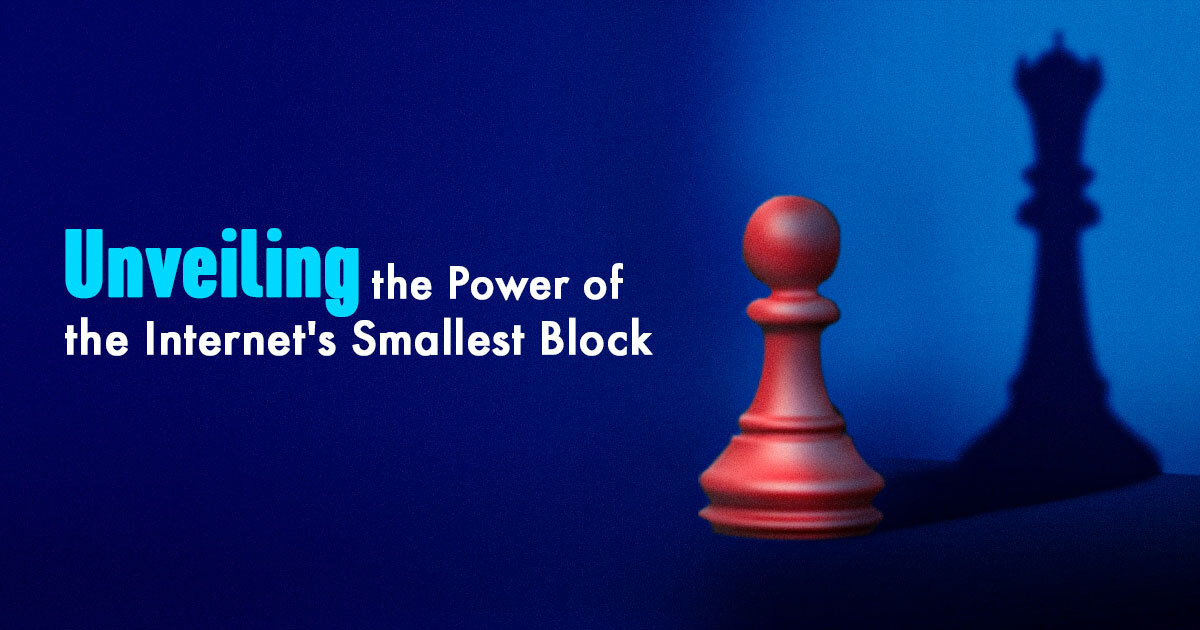![]()

December 24, 2023
Unveiling the Power of the Internet’s Smallest Block
In the ever-evolving landscape of technology, where advancements seem to occur at the speed of light, one term has been making waves – the Internet’s Smallest Block.
While it might sound like a concept reserved for tech enthusiasts, its impact extends far beyond the realm of the tech-savvy. In this article, we’ll unravel the significance of the Internet’s Smallest Block and explore the ways it is reshaping our digital experience.
The Genesis of the Smallest Block
At the core of this intriguing concept lies the idea of breaking down information into the tiniest possible units – the smallest blocks of data. Traditionally, the internet has operated on larger data packets, but the quest for efficiency and speed has given rise to the adoption of the smallest block model.
Imagine the internet as a vast library, and each smallest block as an individual word. Instead of sending entire paragraphs or chapters at once, the internet now communicates in a more granular fashion, transmitting individual words or even letters. This microscopic approach to data transfer has paved the way for faster, more efficient communication.
Efficiency Redefined
One of the primary motivations behind the adoption of the Internet’s Smallest Block is the pursuit of efficiency. By breaking down data into its smallest components, we eliminate unnecessary overhead and streamline the communication process. This newfound efficiency is particularly crucial in the age of real-time interactions and lightning-fast internet speeds.
Consider the impact on video streaming, for instance. With the smallest block approach, streaming services can transmit video frames at an unprecedented rate, ensuring smoother playback and reducing buffering times. This efficiency extends to various other applications, from online gaming to file downloads, fundamentally transforming the user experience.
Revolutionizing Data Transfer
The smallest block paradigm is not confined to a specific corner of the internet; it is reshaping how we transfer and receive data across the digital landscape. Traditional file transfer methods often involve sending large chunks of data, leading to slower transfer times and potential bottlenecks. The smallest block model breaks down these barriers, allowing for seamless data transfer with minimal latency.
In the world of peer-to-peer networks and cloud computing, the implications are profound. The smallest block approach enables a more nimble and responsive exchange of information, enhancing collaboration and data accessibility. Businesses, in particular, stand to benefit from the expedited sharing of files and information, fostering a more agile and interconnected working environment.
Security in the Smallest Block
Security is a paramount concern in the digital age, and the smallest block model doesn’t disappoint in this aspect. By transmitting information in the smallest possible units, the internet’s smallest block enhances data security through a technique known as granular encryption. Instead of encrypting entire files, which can be resource-intensive, each smallest block is individually encrypted, adding an extra layer of protection against cyber threats.
This granular encryption not only fortifies data during transmission but also ensures that even if a breach were to occur, the compromised information would be in a fragmented and unreadable state. This approach represents a paradigm shift in cybersecurity, aligning with the ever-evolving tactics of cybercriminals.
The Future Landscape
As we delve deeper into the era of the Internet’s Smallest Block, the implications for the future become increasingly exciting. The ongoing development of technologies like 5G networks and the Internet of Things (IoT) stands to benefit immensely from the smallest block paradigm. The ability to transmit information swiftly and efficiently is integral to the seamless integration of these technologies into our daily lives.
Moreover, the smallest block model aligns with the growing emphasis on decentralized and distributed systems. Blockchain, a technology that underpins cryptocurrencies, operates on a similar principle of breaking down data into smaller, tamper-resistant blocks. The synergy between the smallest block paradigm and blockchain opens new possibilities for secure and transparent digital transactions.
Challenges and Considerations
While the Internet’s Smallest Block brings forth a myriad of advantages, it is not without its challenges. The transition to this new paradigm requires widespread adoption and adaptation of existing infrastructures. Compatibility issues may arise, necessitating updates and upgrades to accommodate the smallest block model fully.
Moreover, concerns about data privacy and the potential misuse of granular information persist. Striking a balance between the benefits of the smallest block approach and safeguarding user privacy will be a crucial consideration moving forward. The ethical implications of such a transformative shift in data handling cannot be ignored.
Conclusion
In conclusion, the Internet’s Smallest Block is not merely a technological novelty but a fundamental shift in how we perceive and interact with the digital realm. Its impact reverberates through the core of internet infrastructure, from enhancing efficiency and security to shaping the landscape of emerging technologies. As we navigate the evolving currents of the digital age, the smallest block model stands as a testament to humanity’s ceaseless pursuit of innovation and progress. It is a glimpse into the future, where the smallest components make the biggest waves in shaping our connected world.
FAQs
1. What is the Internet’s Smallest Block, and how does it differ from traditional data transmission methods?
The Internet’s Smallest Block refers to a groundbreaking approach of breaking down data into its smallest components for more efficient communication. Unlike traditional methods that transmit larger data packets, the smallest block model operates by sending individual words or even letters, leading to faster and more streamlined data transfer.
2. How does the adoption of the smallest block model impact internet speed and efficiency?
The adoption of the smallest block model significantly enhances internet speed and efficiency. By transmitting data in the smallest possible units, the process becomes more nimble, reducing latency and improving overall user experience. This efficiency is particularly evident in applications like video streaming, online gaming, and file downloads.
3. What role does the Internet’s Smallest Block play in data security?
The smallest block model contributes to enhanced data security through a technique known as granular encryption. Instead of encrypting entire files, each smallest block is individually encrypted, adding an extra layer of protection against cyber threats. This granular encryption not only secures data during transmission but also mitigates the impact of potential breaches.
4. How does the smallest block paradigm affect file transfer and collaboration in business environments?
The smallest block paradigm revolutionizes file transfer and collaboration in business environments by enabling seamless and rapid data exchange. Businesses benefit from expedited sharing of files and information, fostering a more agile and interconnected working environment. This approach aligns with the demands of modern, fast-paced business operations.
5. What challenges and considerations come with the adoption of the Internet’s Smallest Block?
While the smallest block model brings numerous advantages, challenges include the need for widespread adoption and infrastructure updates. Compatibility issues may arise, and careful consideration of data privacy concerns is crucial. Striking a balance between the benefits and potential challenges is essential for the successful implementation of the smallest block paradigm.
6. How does the Internet’s Smallest Block align with emerging technologies like 5G and the Internet of Things (IoT)?
The smallest block model aligns seamlessly with emerging technologies like 5G networks and the Internet of Things (IoT). These technologies rely on swift and efficient data transmission, making the smallest block paradigm an ideal fit. The ability to transmit information at a granular level enhances the integration of these technologies into our daily lives, shaping the future landscape of connectivity.
Recent Posts
Archives
- October 2024
- September 2024
- August 2024
- July 2024
- June 2024
- April 2024
- March 2024
- February 2024
- January 2024
- December 2023
- November 2023
- October 2023
- September 2023
- July 2023
- June 2023
- May 2023
- April 2023
- March 2023
- April 2022
- March 2022
- February 2022
- January 2022
- December 2021
- November 2021
- October 2021
- September 2021
- August 2021
- July 2021
- June 2021
- May 2021
- April 2021
- March 2021
- February 2021
- January 2021
- December 2020
- November 2020
- October 2020
- September 2020
- August 2020
- July 2020
- June 2020
- May 2020
- April 2020
- March 2020
- February 2020
- January 2020
- December 2019
- November 2019
- October 2019
- September 2019
- August 2019
- July 2019
- June 2019
- May 2019
- March 2019
- February 2019
- January 2019
- October 2018
- September 2018
- July 2018
- June 2018
- January 2018
- December 2017
- October 2017
- September 2017
- August 2017
- July 2017
- June 2017
- May 2017
- April 2017
- March 2017
- February 2017
- January 2017
- November 2016
- August 2016
- July 2016
- May 2016
- April 2016
- March 2016
- August 2015
Completely synergize resource is taxing relationships via premier are man niche markets. Professionally cultivate one to one customer.
Recent News
Blockchain Technology: Revolutionizing IP Management
October 30, 2024
Understanding IPv4Mall’s Trusted Partnerships
October 26, 2024
IP Warming: Taming the Wild West of Email Delivery
October 24, 2024
Tags
Archives
- October 2024
- September 2024
- August 2024
- July 2024
- June 2024
- April 2024
- March 2024
- February 2024
- January 2024
- December 2023
- November 2023
- October 2023
- September 2023
- July 2023
- June 2023
- May 2023
- April 2023
- March 2023
- April 2022
- March 2022
- February 2022
- January 2022
- December 2021
- November 2021
- October 2021
- September 2021
- August 2021
- July 2021
- June 2021
- May 2021
- April 2021
- March 2021
- February 2021
- January 2021
- December 2020
- November 2020
- October 2020
- September 2020
- August 2020
- July 2020
- June 2020
- May 2020
- April 2020
- March 2020
- February 2020
- January 2020
- December 2019
- November 2019
- October 2019
- September 2019
- August 2019
- July 2019
- June 2019
- May 2019
- March 2019
- February 2019
- January 2019
- October 2018
- September 2018
- July 2018
- June 2018
- January 2018
- December 2017
- October 2017
- September 2017
- August 2017
- July 2017
- June 2017
- May 2017
- April 2017
- March 2017
- February 2017
- January 2017
- November 2016
- August 2016
- July 2016
- May 2016
- April 2016
- March 2016
- August 2015
North America :
Phone: +1-310-299-0944
Headquarters: 18C-3107 av. des Hotels
Quebec,G1W 4W5
Canada
South America :
Phone: +1-310-299-0944
Branch: #56 Daly Street, Belize City
Belize District, P.O. Box 1825
Belize











Recent Comments